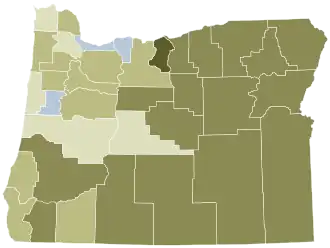Oregon Ballot Measure 117
Ranked-Choice Voting for Federal and State Elections Measure: Gives voters option to rank candidates in order of preference; candidates receiving majority of votes in final round wins. | ||||||||||
| Results | ||||||||||
|---|---|---|---|---|---|---|---|---|---|---|
| ||||||||||

| ||||||||||
Oregon Ballot Measure 117, the Ranked-Choice Voting for Federal and State Elections Measure, was a proposed Oregon state initiative that was decided by voters as part of the 2024 Oregon elections on November 5, 2024.[1][2] If approved, primary and general elections for statewide and federal offices would have been done through ranked-choice (instant-runoff) voting, as opposed to the current plurality voting system, starting in 2028. It would also have made the office of the secretary of state provide voter education on how to use the system.[3]
Background
Other states that have adopted similar measures are Maine and Alaska. Two Oregon counties have already adopted RCV for local elections, being Benton and Multnomah.[4]
Polling
| Poll source | Date(s)
administered |
Sample
size[a] |
Margin
of error |
For Measure 117 | Against Measure 117 | Undecided |
|---|---|---|---|---|---|---|
| Public Policy Polling (D)[5][b] | October 16–17, 2024 | 716 (LV) | ± 3.7% | 41% | 40% | 20% |
- ^ Key:
A – all adults
RV – registered voters
LV – likely voters
V – unclear - ^ This poll was sponsored by the Northwest Progressive Institute
Results
Vote tallies by county:[6]
| County | Yes | Votes | No | Votes | Total |
|---|---|---|---|---|---|
| Baker | 24.21 | 2,241 | 75.79 | 7,017 | 9,258 |
| Benton | 56.79 | 27,239 | 43.21 | 20,725 | 47,964 |
| Clackamas | 38.67 | 88,555 | 61.33 | 140,454 | 229,009 |
| Clatsop | 41.11 | 9,000 | 58.89 | 12,895 | 21,895 |
| Columbia | 34.03 | 10,130 | 65.97 | 19,639 | 29,769 |
| Coos | 30.63 | 10,283 | 69.37 | 23,287 | 33,570 |
| Crook | 23.79 | 3,712 | 76.21 | 11,891 | 15,603 |
| Curry | 32.30 | 4,263 | 67.70 | 8,935 | 13,198 |
| Deschutes | 41.93 | 50,258 | 58.07 | 69,606 | 119,864 |
| Douglas | 25.80 | 15,173 | 74.20 | 43,628 | 58,801 |
| Gilliam | 23.79 | 260 | 76.21 | 833 | 1,093 |
| Grant | 23.25 | 979 | 76.75 | 3,231 | 4,210 |
| Harney | 21.19 | 864 | 78.81 | 3,214 | 4,078 |
| Hood River | 51.96 | 6,172 | 48.04 | 5,707 | 11,879 |
| Jackson | 38.68 | 43,580 | 61.32 | 69,098 | 112,678 |
| Jefferson | 28.90 | 3,237 | 71.10 | 7,965 | 11,202 |
| Josephine | 27.49 | 12,720 | 72.51 | 33,545 | 46,265 |
| Klamath | 26.72 | 8,919 | 73.28 | 24,460 | 33,379 |
| Lake | 21.23 | 854 | 78.77 | 3,168 | 4,022 |
| Lane | 43.96 | 87,502 | 56.04 | 111,562 | 199,064 |
| Lincoln | 43.20 | 12,166 | 56.80 | 15,998 | 28,164 |
| Linn | 30.68 | 20,842 | 69.32 | 47,098 | 67,940 |
| Malheur | 23.97 | 2,494 | 76.03 | 7,909 | 10,403 |
| Marion | 35.38 | 52,631 | 64.62 | 96,108 | 148,739 |
| Morrow | 24.88 | 1,108 | 75.12 | 3,345 | 4,453 |
| Multnomah | 56.95 | 220,355 | 43.05 | 166,600 | 386,955 |
| Polk | 35.44 | 15,992 | 64.56 | 29,138 | 45,130 |
| Sherman | 18.34 | 205 | 81.66 | 913 | 1,118 |
| Tillamook | 34.96 | 5,369 | 65.04 | 9,990 | 15,359 |
| Umatilla | 28.23 | 8,253 | 71.77 | 20,982 | 29,235 |
| Union | 27.84 | 3,876 | 72.16 | 10,046 | 13,922 |
| Wallowa | 29.01 | 1,402 | 70.99 | 3,430 | 4,832 |
| Wasco | 34.22 | 4,310 | 65.78 | 8,285 | 12,595 |
| Washington | 49.47 | 139,282 | 50.53 | 142,245 | 281,527 |
| Wheeler | 24.82 | 207 | 75.18 | 627 | 834 |
| Yamhill | 35.18 | 19,235 | 64.82 | 35,439 | 54,674 |
See also
- 2024 United States ballot measures
- List of Oregon ballot measures
- Ranked-choice voting in the United States
References
- ^ Bourgeois, Michaela (August 2, 2024). "Oregon voters to decide on 5 ballot measures in 2024 November election". KOIN. Retrieved October 28, 2024.
- ^ Fuentes, Carlos (October 13, 2024). "Election 2024: Your guide to Oregon's November election". The Oregonian. Retrieved October 28, 2024.
- ^ Lugo, Dianne. "What is Ballot Measure 117? Oregonians to decide adoption of ranked-choice voting". Statesman Journal. Retrieved 2024-10-28.
- ^ "Measure 117, ranked-choice voting, explained in comics". opb. Retrieved 2024-10-28.
- ^ Villeneuve, Andrew (October 24, 2024). "Oregon voters are split on ranked choice voting initiative, while poised to reject rebate plan and accept constitutional changes". Northwest Progressive Institute. Retrieved November 3, 2024.
- ^ "November 5, 2024, General Election Abstract of Votes" (PDF). Oregon Secretary of State. November 5, 2024. Retrieved July 18, 2025.